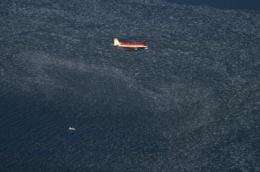Polar 5 tows a probe for sea ice thickness measurements -- the so called EM-Bird -- on a test flight. Credit: Christian Haas, University of Alberta / Alfred Wegener Institute
The extent of the sea ice in the Arctic will reach its annual minimum in September. Forecasts indicate that it will not be as low as in 2007, the year of the smallest area covered by sea ice since satellites started recording such data. Nevertheless, sea ice physicists at the Alfred Wegener Institute are concerned about the long-term equilibrium in the Arctic Ocean.
They have indications that the mass of sea ice is dwindling because its thickness is declining. To substantiate this, they are currently measuring the ice thickness north and east of Greenland using the research aircraft Polar 5. The objective of the roughly one-week campaign is to determine the export of sea ice from the Arctic. Around a third to half of the freshwater export from the Arctic Ocean takes place in this way - a major drive factor in the global ocean current system.
The question of when the Arctic will be ice-free in the summer has been preoccupying the sea ice researchers headed by Prof. Dr. Rüdiger Gerdes from the Alfred Wegener Institute for Polar and Marine Research in the Helmholtz Association for a long time now. Satellites have been recording the extent of the Arctic ice for more than 30 years. In addition to the area covered, the thickness of the ice is a decisive factor in assessing how much sea ice there is.
However, the thickness can only be determined locally, for example by means of the so-called EM-Bird, an electromagnetic measuring device which helicopters or planes tow over the ice. For Gerdes this is a very special job because he usually models his forecasts on his home computer. The campaign with the research aircraft Polar 5 of the Alfred Wegener Institute now takes him on an expedition in the Arctic for the first time. "I'm very keen on seeing the results of the sea ice thickness measurements," says Gerdes. "Only when we know the distribution of ice of varying thickness, can we calculate how much freshwater is carried out of the Arctic Ocean via ice."
About 3000 cubic kilometres of ice drift out of the Arctic Ocean every year, corresponding to around 2700 billion tons. The ice exports freshwater that reaches the Arctic Ocean via rivers and precipitation. This maintains its salt concentration, which has been constant over the long term. The temperature rise observed worldwide is especially pronounced in the Arctic latitudes. Researchers have been observing that the ice is getting thinner and thinner for several years now.
As a result, it stores and exports less freshwater and the salt concentration (also referred to as salinity) of the Arctic Ocean declines. On the one hand, this influences all living things that have adapted to the local conditions. On the other hand, changes in salinity also have an impact on current patterns of global ocean circulation and thus on meridional heat transport. In the TIFAX (Thick Ice Feeding Arctic Export) measurement campaign the researchers are primarily interested in ice that is several years old, several metres thick and occurs predominantly on the northern coast of Greenland.
"Taking off on the measurement flights from Station Nord here is a special adventure," reports Gerdes from one of the northernmost measuring stations in the world. "Flying through virtually unsettled regions of the Arctic in the high-tech research aircraft is a stark contrast to my modelling work on the computer."
Provided by Helmholtz Association of German Research Centres





















